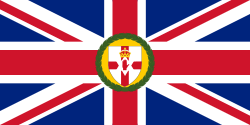Governor of Northern Ireland
This article needs additional citations for verification. (February 2021) |
| Governor of Northern Ireland | |
|---|---|
 | |
| Style | Excellency |
| Residence | Hillsborough Castle |
| Appointer | British Monarch |
| Precursor | Lord Lieutenant of Ireland |
| Formation | 9 December 1922 |
| First holder | The 3rd Duke of Abercorn |
| Final holder | The Lord Grey of Naunton |
| Abolished | 18 July 1973 |
| Succession | Secretary of State for Northern Ireland |
The governor of Northern Ireland was the principal officer and representative in Northern Ireland of the British monarch. The office was established on 9 December 1922 and abolished on 18 July 1973.
Overview[]
The office of Governor of Northern Ireland was established on 9 December 1922 under Letters Patent to:[1]
do and execute in due manner as respects Northern Ireland all things which by virtue of the [1920] Act and our said Letters Patent of 27 April 1921 or otherwise belonged to the office of Lord Lieutenant at the time of the passing of the Irish Free State Constitution Act 1922.
The governor had possession of the Great Seal of Northern Ireland.
The governor was the successor to the lord lieutenant of Ireland in Northern Ireland, itself established on 3 May 1921.[2] The office of the Governor was abolished on 18 July 1973 under Section 32 of the Northern Ireland Constitution Act 1973.[3] The secretary of state for Northern Ireland, a cabinet office that had been created in 1972, took over the functions of the governor on 20 December 1973 under Letters Patent.
Official residence[]
The official residence of the governor of Northern Ireland was Hillsborough Castle in County Down. Following refurbishment of the Castle, the Duke of Abercorn took up residence in 1925. It remained the official residence until the abolition of the office of governor in 1973; henceforth it has been the official residence of the secretary of state for Northern Ireland.
Governors of Northern Ireland (1922–73)[]
| No. | Portrait | Name (Birth–Death) |
Term of office | Monarch | Prime Minister | ||
|---|---|---|---|---|---|---|---|
| Took office | Left office | Time in office | |||||
| 1 | 
|
Duke of Abercorn (1869–1953) |
12 December 1922 | 6 September 1945 | 22 years, 268 days | George V Edward VIII George VI |
Craigavon Andrews Brooke |
| 2 | 
|
Earl Granville (1880–1953) |
7 September 1945 | 1 December 1952 | 7 years, 85 days | George VI Elizabeth II |
Brooke |
| 3 | 
|
Lord Wakehurst (1895–1970) |
1 December 1952 | 1 December 1964 | 12 years, 0 days | Elizabeth II | Brookeborough O'Neill |
| 4 | 
|
Lord Erskine of Rerrick (1893–1980) |
1 December 1964 | 27 November 1968 | 3 years, 362 days | O'Neill | |
| 5 | Lord Grey of Naunton (1910–1999) |
27 November 1968 | 26 June 1973 | 4 years, 211 days | O'Neill Chichester-Clark Faulkner | ||
Deputies[]
The 1922 "Instructions" sent alongside the letters patent establishing the office required the governor of Northern Ireland to get the monarch's permission to leave Northern Ireland, and empowered the governor in such cases to issue letters patent under the Great Seal of Northern Ireland appointing a "Deputy or Deputies, Justice or Justices" during his absence. This emulated the practice of appointing Lords Justices of Ireland when the lord lieutenant was absent from Ireland. Each new governor upon taking office would select a slate of eligible deputies from among the Privy Council of Northern Ireland, and at each of his subsequent absences a subset of these would be sworn in for its duration.[4] Many were Lord Chief Justice or Lord Justice of Appeal: Denis Henry,[5][6] William Moore,[5][6][7][8] James Andrews,[5][6][7][8][9] Anthony Babington,[9] John MacDermott, Baron MacDermott,[10] Samuel Clarke Porter.[10] Others were Senators and/or county lieutenants: Robert Sharman-Crawford,[6][7] Robert David Perceval-Maxwell,[6] Henry Armstrong,[7][8] Sir Thomas Dixon, 2nd Baronet,[8][9] Maurice McCausland,[8] Francis Needham, 4th Earl of Kilmorey.[9][10]
See also[]
References[]
- ^ House of Lords, Northern Ireland Bill, Memorandum by the Northern Ireland Office. Archived 2011-06-05 at the Wayback Machine
- ^ 3 May 1921 was the "appointed day" under the Government of Ireland Act 1920, upon which the Parliaments of Northern Ireland and Southern Ireland were established,(SR&O 1921, No. 533).
- ^ A New History of Ireland by Theodore William Moody, Francis John.
- ^ Quekett 1933 Vol.2 pp.70–71
- ^ Jump up to: a b c The Belfast Gazette No. 81 p.17
- ^ Jump up to: a b c d e The Belfast Gazette No. 161 p.880
- ^ Jump up to: a b c d The Belfast Gazette No. 579 p.403
- ^ Jump up to: a b c d e The Belfast Gazette No. 705 p.451
- ^ Jump up to: a b c d The Belfast Gazette No. 1265 p.217
- ^ Jump up to: a b c The Belfast Gazette No. 1577 p.219
Sources[]
- Quekett, Arthur S. (1928). The Constitution Of Northern Ireland. Part I: The Origin and Development of the Constitution. Belfast: HMSO.
- Quekett, Arthur S. (1933). The Constitution Of Northern Ireland. Part II: The Government of Ireland Act 1920 and Subsequent Enactments. Belfast: HMSO.
Further reading[]
- Mansergh, Nicholas (1936). "The Executive; The Governor of Northern Ireland". The government of Northern Ireland; a study in devolution. London: G. Allen & Unwin. pp. 169–174 – via Internet Archive.
- Lowry, Donal (2020). Kumarasingham, Harshan (ed.). A ‘Supreme and Permanent Symbol of Executive Authority’: The Crown and the Governorship of Northern Ireland in an Age of Troubles. Viceregalism: The Crown as Head of State in Political Crises in the Post-War Commonwealth. London: Palgrave-Macmillan. pp. 93–126. doi:10.1007/978-3-030-46283-3_4. ISBN 978-3-030-46282-6.
- Government of Northern Ireland
- History of Northern Ireland
- Governors in the British Islands
- 1922 establishments in the United Kingdom
- 1973 disestablishments in the United Kingdom
